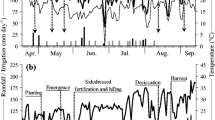Abstract
Phosphorus deficiency affects already in the early stages of plant development, with a lack of phosphorus, their growth slows down sharply, the leaves change color (first from the edges, and then over the entire surface) to gray-green or red-violet, the number of fruit elements and their sizes decrease. It has been established that with a low level of phosphorus nutrition, the degree of absorption of nitrogen fertilizers also decreases, which can lead to a dangerous accumulation of excess amounts of nitrates in plants and soils. New concentrated phosphate fertilizers have a positive effect on the development of cotton plants, stimulating the growth of plant organs by 3–19% and increasing yield by 6.4–12.2%. Lysimetric experiments showed that ammaphos and concentrated phosphate fertilizers showed a positive effect on both phenological indicators and biometric characteristics of the development of cotton plants, stimulating the growth of plant organs. At the same time, the formation of vegetative and reproductive biomass is probably provided to a greater extent due to the use of nutrients by plants that are part of these fertilizers.
Access this chapter
Tax calculation will be finalised at checkout
Purchases are for personal use only
Similar content being viewed by others
References
Mirziyoev S (2016) Decree of the President of the Republic of Uzbekistan No. PP - 2640 dated October 24, 2016 “On measures to improve the system of plant protection and agrochemical services for agriculture”
Mirziyoev S (2016) Decree of the Cabinet of Ministers of the Republic of Uzbekistan No. 03-2-7 dated December 26, 2016 “Comprehensive program of measures to develop a system for providing agriculture with mineral fertilizers, chemical and biological plant protection products, improving the quality of agrochemical services for the period 2017–2020”
Decree of the President of the Republic of Uzbekistan dated August 23, 2017 “On the Program for the Development of the Chemical Industry for 2017–2021”, and other regulatory documents
Efimov VN, Donskikh IN, Tsarenko VK (2002) Aertilizer system. Kolos Press, Moscow, p 320
Kulakov VA, Altunin DA (2017) Results of long-term studies on the effect of mineral and organic fertilizers on the productive and environment-forming potential of pasture agrophytocenoses. Modern ecological state of the natural environment and scientific and practical aspects of rational nature management. In: II international scientific and practical internet conference. FGBNU, Caspian Research Institute of Arid Agriculture, Salty Zaimishche, pp 490–494
Korchagin AA, Mazirov MA, Komarova NA (2018) Fertilizer system: textbook. Vladim. State Un-t im. A.G. and N.G. Stoletovs. Publishing House of VlGU, Vladimir, p 116
Myachina OV (2018) Structural and functional features of microbial communities in a typical gray soil under the influence of phosphate fertilizers. Dissertation, Doctor of Biological Sciences, p 180
Sychev VG (2000) Guidelines for determining the balance of nutrients: nitrogen, phosphorus, potassium, humus, calcium. TsINAO Publishing House, p 40
Methods of microbiological research and determination of trace elements (2003) SoyuzNIHI Press, Tashkent, p 105
Methods of field and vegetation experiments with cotton (1991). SoyuzNIHI Press, Tashkent, p 368
Khan HGA, Ahmad A, Siraj A (2010) Impact of rising prices of fertilizers on crops production in Pakistan. Glob J Manage Bus Res 10(9):144–151
Turgumbaeva KK, Lapshina IZ, Beisekova TI et al (2017) Innovative methods for processing waste from the phosphorus industry. Ecological, industrial and energy security—2017. In: Collection of articles of a scientific and practical conference with international participation, vol 228. Sevastopol State University, Sevastopol, p 230
Uktamov DA (2019) Development of a rational technology for obtaining microelement-containing (Cu, Zn, Mo) superphosphate and nitrophos. Author. Doctor of Philosophy (PhD) dissertation in tech. Sciences. Tashkent, p 47
Bergström L, Kirchmann H, Djodjic F et al (2015) Turnover and losses of phosphorus in Swedish agricultural soils: long-term changes, leaching trends, and mitigation measures. J Environ Qual 44:512–523
Delin S (2016) Fertilizer value of phosphorus in different residues. Soil Use Manag 32:17–26
Maarten E (2017) Perspectives on the Direct use of mineral phosphorus recovery products as slow-release fertilizers. Agri Res & 002 Tech: Open Access J 9(5):555773
Sovuthy P, Bell RW, White PF, Kirk GJD (2005) Phosphorus mass balances for successive crops of fertilised rainfed rice on a sandy lowland soil. Field Crop Res 73(6):277–292
Svanbäck A, Ulén B, Etana A (2014) Mitigation of phosphorus leaching losses via subsurface drains from a cracking marine soil. Agric Ecosyst Environ 184:124–134
Syers JK, Johnston AE, and Curtin D (2008) Efficiency of soil and fertilizer phosphorus use. FAO Fertilizer and Plant Nutrition Bull 18, FAO, Rome
Svanbäck A, Ulén B, Etana A et al (2013) Influence of soil phosphorus and manure on phosphorus leaching in Swedish topsoils. Nutr Cycling Agroecosyst 96:133–147
Author information
Authors and Affiliations
Corresponding author
Editor information
Editors and Affiliations
Rights and permissions
Copyright information
© 2024 The Author(s), under exclusive license to Springer Nature Switzerland AG
About this paper
Cite this paper
Asatova, S., Myachina, O. (2024). Influence of Concentrated Slow-Acting Phosphate Fertilizers on the Growth Dynamics and Development of Plants and Cotton Yield. In: Zokirjon ugli, K.S., Muratov, A., Ignateva, S. (eds) Fundamental and Applied Scientific Research in the Development of Agriculture in the Far East (AFE-2022). AFE 2023. Lecture Notes in Networks and Systems, vol 733. Springer, Cham. https://doi.org/10.1007/978-3-031-37978-9_61
Download citation
DOI: https://doi.org/10.1007/978-3-031-37978-9_61
Published:
Publisher Name: Springer, Cham
Print ISBN: 978-3-031-37977-2
Online ISBN: 978-3-031-37978-9
eBook Packages: Intelligent Technologies and RoboticsIntelligent Technologies and Robotics (R0)




